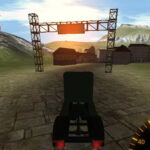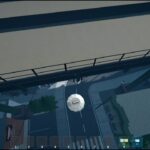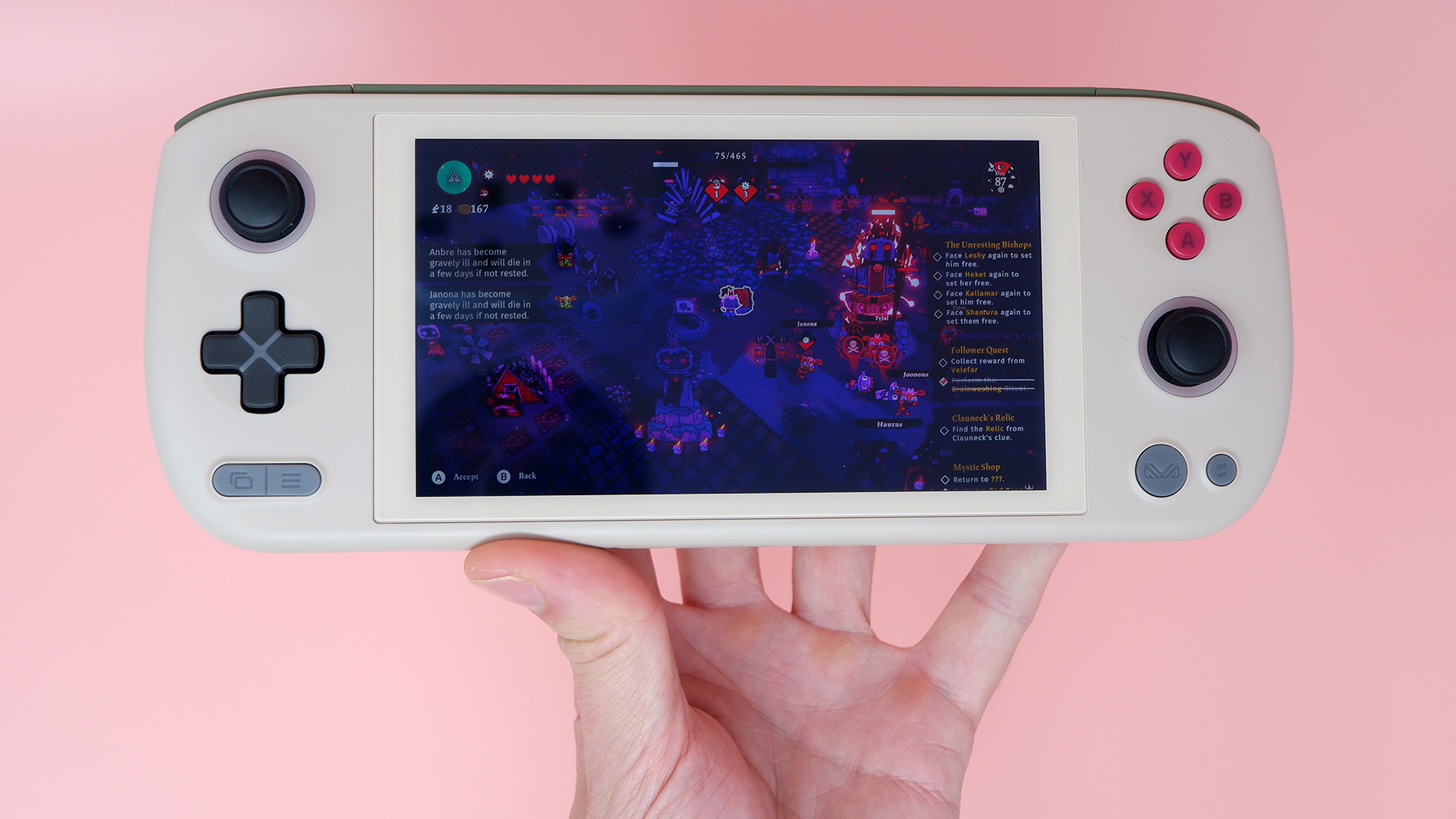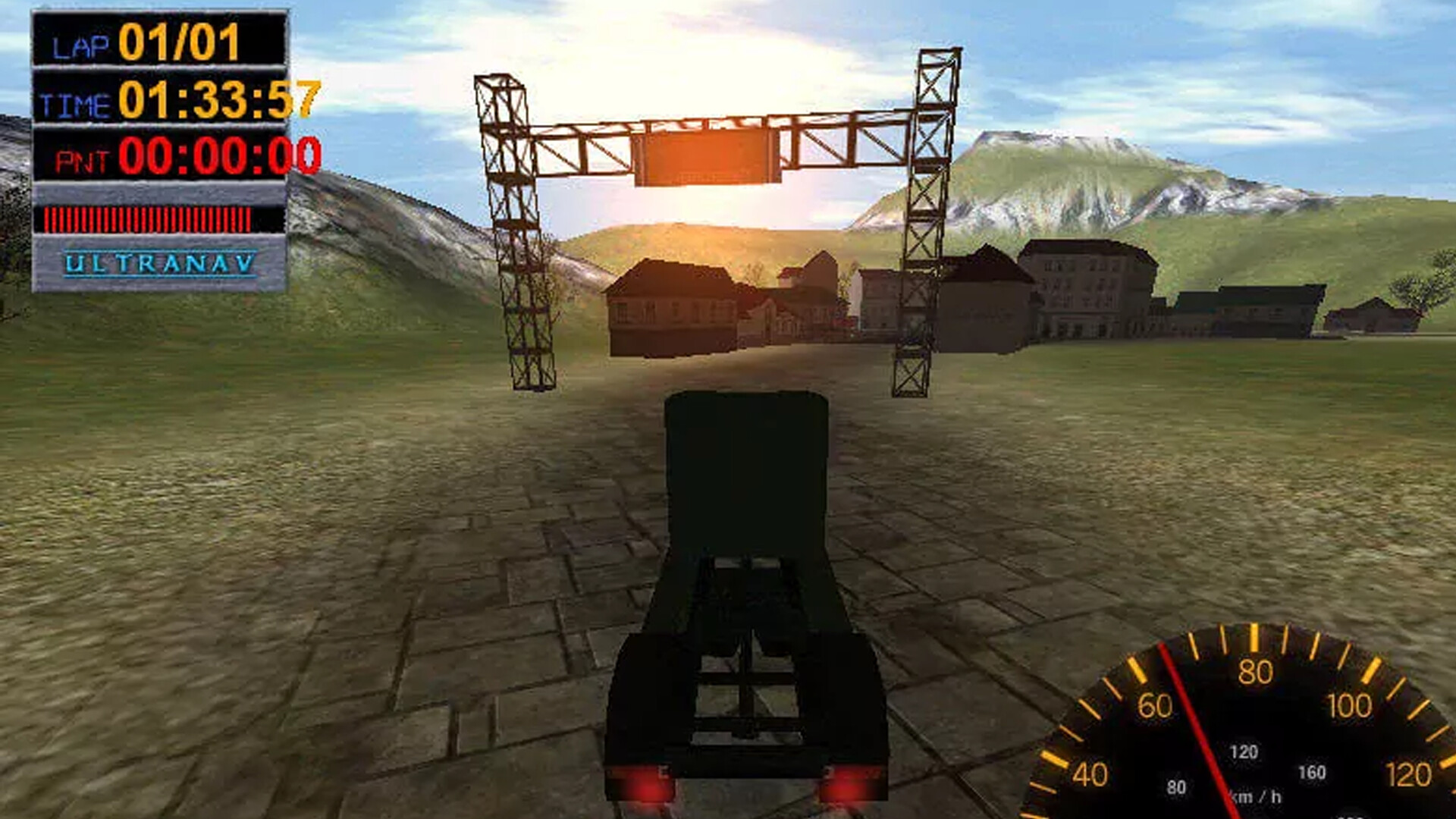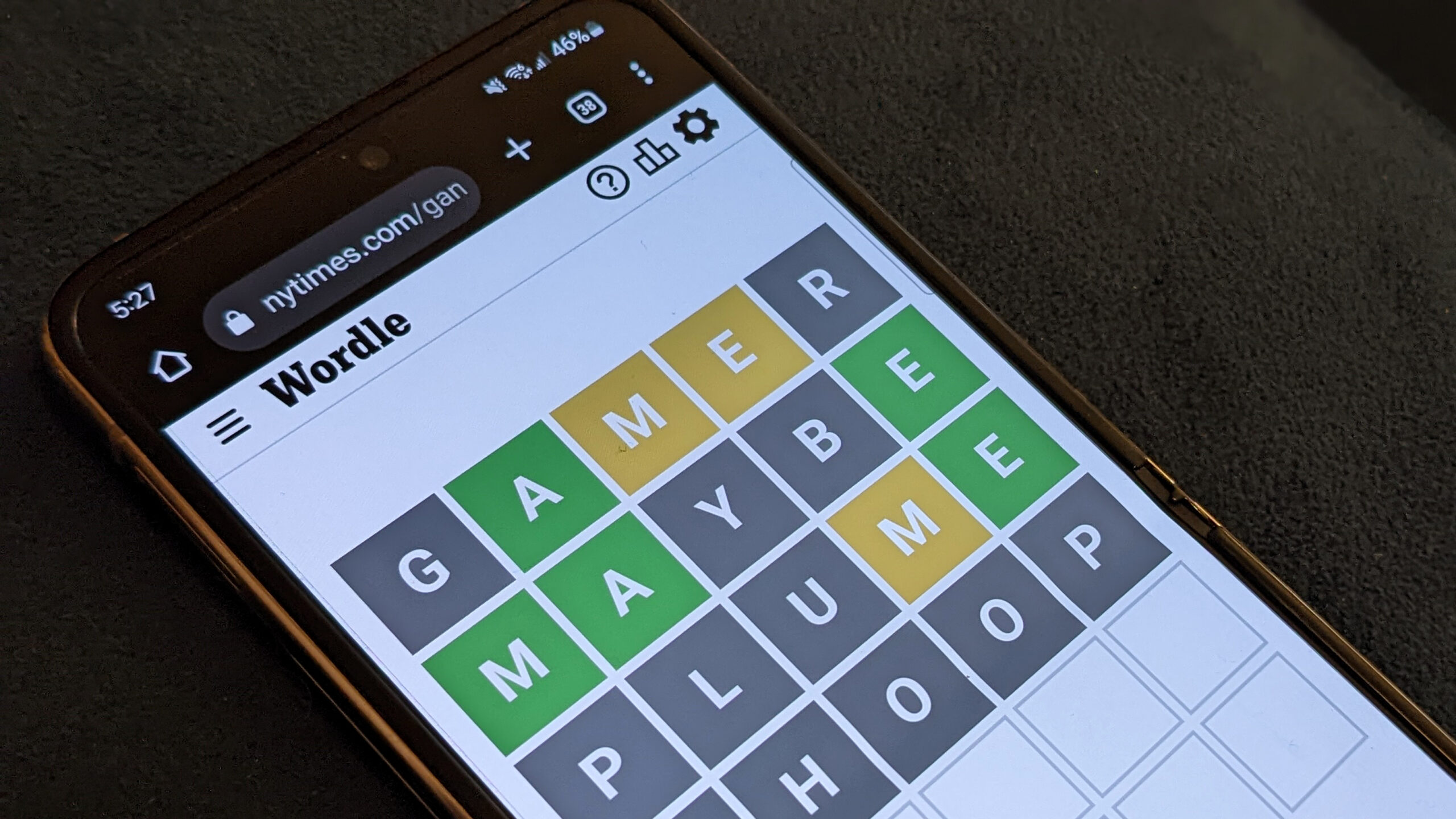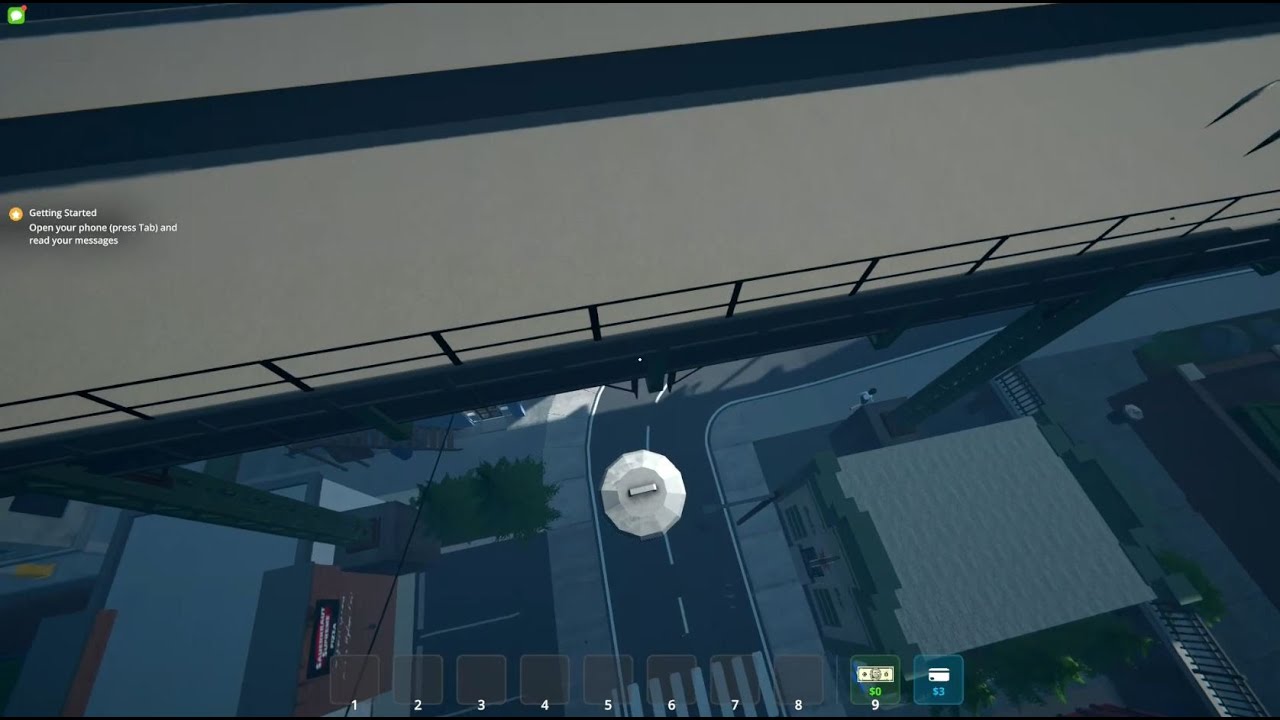I often spare a thought as to whether I should pack my Steam Deck when travelling and trying to pack light. It’s a fine problem to have: my portable PC isn’t quite portable enough to slip it into my backpack without debating it in my head. Should I? Shouldn’t I? Often I side with taking it anyways, but now that I’ve tried a slimmer device in the Ayaneo Air 1S, I don’t spare a second thought on packing it with me. I’m all about that compact form factor.
At 22.5 x 9 x 3 cm, the Ayaneo Air 1S is more like a Nintendo Switch than a Steam Deck. In fact, it’s a touch smaller than the Switch. Or slightly bigger than a medium-large banana. The retro model I’ve got in for review weighs only ~405g on my scales, which is a little heavier than my Switch at around ~400g but far lighter than my Steam Deck at ~650g. There’s even a thinner and lighter model, the Air 1S Thin, though that’s a limited edition.
Point is, it’s a handheld gaming PC that feels more like a handheld gaming device of old than any other I’ve used. It’s a powerful GameBoy Advance, and boy, is it powerful.
The Ayaneo Air 1S may look like it needs a downgrade to stuff all its parts into that tiny shell. But, no. It comes with the same AMD Ryzen 7 7840U chip found within the AOKZOE A1 Pro or the OneXPlayer OneXFly. That’s a full eight-core, 16-thread Zen 4 processor. I still can’t really believe that sort of spec comes in a compact PC at all. It’s paired up with a Radeon 780M integrated graphics, powered by 12 RDNA 3 CUs—four more CUs than the Steam Deck’s RDNA 2 chip.
(Image credit: Future)
Processor: AMD Ryzen 7 7840U
Cores/Threads: 8/16
GPU: AMD RDNA 3 (12CUs)
Memory: 32GB LPDDR5X
Screen: 5.5-inch
Resolution: 1920 x 1080
Refresh rate: 60Hz
Peak luminance: 350 nits
Battery: 38Wh
I/O: 2x USB 4.0 Type-C, 3.5mm audio, MicroSD
Dimensions: 22.5 x 9 x 3 cm
Weight: ~405g
Price (review model): $1,029 (early bird) | $1,179 (retail)
Price (cheapest): $799 (early bird) | $899 (retail)
It’s perhaps an unfair comparison to the Steam Deck, a more budget-friendly offering that launched prior to the 7840U’s launch, but that’s such a prolific handheld it’s a great marker as to how far handhelds have come in just a year and a half.
Take, for example, the Ayaneo’s memory and SSD configuration. The model I have comes with 32GB of LPDDR5X memory and a 2TB 2280 NVMe SSD. Yeah, 2280. If you’re familiar with the Steam Deck, or really most PC gaming handhelds, you’ll know they use the compact 2230 SSD form factor. That’s not the case here. This is a full 2280 SSD. Though I do admit that Ayaneo’s claims of this making for an easy SSD upgrade didn’t go as easily as I’d hoped. I removed the only 3 visible screws on the device and tried to lightly pry the rear off, but to no success. It felt like I was going to break it. Perhaps there’s a fourth screw under the label, but this is a loaner and I didn’t want to push it just to double check the SSD config. I’ll take your word for it, Ayaneo.
The Ayaneo is stuffing a lot of memory and storage into this machine for not as much money as you’d think, however. This 2TB + 32GB model is available (admittedly only for preorder today) for $1,029, or £834. Its usual price will be $1,179 once it’s on sale proper. The budget Steam Deck, this is not. But I would say that for a 32GB, 2TB, eight-core Zen 4-powered PC, that’s not an awful price.
(Image credit: Future)
I suppose when you swap out the high-end graphics card for integrated graphics, you naturally save a wad of cash. It still puts some pre-built machines with a paltry 8GB of RAM or a 512GB SSD to shame.
This device comes with a 5.5-inch 1080p AMOLED screen; not the biggest panel for in-depth strategy games or tons of text, but it’s generally able to deliver a very crisp overall image. I don’t mind its restricted real estate at all. My Steam Deck has become my pathway to playing more indie games than I ever normally would, and the Ayaneo fulfils that role incredibly well.
One reason why this specific device is better suited to indie darling than triple-A workhorse is that, for its compact size—it’s limited for the amount of power it can suck up. Its top TDP is 25W, though it’s not really meant to run at that all the time. In Game Mode it’ll run at 22W. You won’t even be running at that most of the time, either. On battery power alone, it’s a 20W chip max, as the slim battery can’t keep up.
(Image credit: Future)
Bear in mind that the 7840U itself can run up to 30W, and some handhelds do allow for that, meaning you are making a performance sacrifice on the Ayaneo for its size.
A portable PC that even five years ago I wouldn’t have thought possible.
I’m sure to some that’s a deal breaker—you want the top performance out of your handheld like you would a desktop PC. But I don’t mind. I’m fortunate to have a desktop PC I can push frankly absurd wattage through to run games at high settings, and when I’m travelling abroad, commuting, or just lying in bed, I prefer the convenience of the Ayaneo Air 1S.
Though what’s less convenient is the battery life. Like most PC handhelds, the Ayaneo doesn’t last long away from the outlet. But it’s also one of the worst handhelds in terms of battery life, namely for its small stature. Even in 20W mode, it only last a little over an hour in PCMark 10’s gaming benchmark, which puts it second only to the ROG Ally at 28W. That said, if you optimise the Ally it easily outlives the Ayaneo, which really means the Ayaneo is dead last for battery life.
It’s a good hour away from the plug socket, but no doubt it does make this super-portable handheld rather more limited than it appears when you’re out and about.
(Image credit: Future)
It is easy to tweak the TDP down even further, however, which is handy if you’re playing an indie game that doesn’t require much graphical grunt. The OS is as convenient as it gets. While I’m a fan of the Steam Deck’s SteamOS, powered by Linux, I’m surprised by how well Windows 11 suits the compact Air 1S. Part of that is the pop-up control panel, reminiscent of the Steam Deck’s, which can be brought up at the push of a button to control the Ayaneo at a system level.
Another reason is that Ayaneo has two hidden buttons along the top of the device, one of which is set to promptly bring up the on-screen keyboard.
And the desktop shortcut button. And the fingerprint scanner for Windows Hello. And the way the screen orientation flips with the device if you can’t quite see an entire window.
Flick through the gallery below for some size comparisons with the Nintendo Switch and Steam Deck. And a banana, for scale.
(Image credit: Future)
(Image credit: Future)
(Image credit: Future)
(Image credit: Future)



Admittedly, I do miss the Steam Deck’s dual trackpads, which is something I never thought I’d say after the Steam Controller. But I do. They are a good way to navigate the desktop, and while the analogue sticks are decent on the Air 1S (they’re Hall Effect sticks), if you’re considering a lot of desktop surfing then you want to plug in a mouse. That’s easily done, however, as this thing comes with dual USB4 Type-C connections and Bluetooth.
Essentially, the Ayaneo offers a polished Windows 11 experience, and it brings a lot of what I like about the Steam Deck’s OS in a device that can also run Destiny 2, or Fortnite, or any other game that has been forbade from Valve’s open OS, thanks to Ayaneo’s software. That ease of install also extends to Windows-based apps.
After using the Ayaneo Air 1S for a month now, I’ve come to really love it. The tough question to ask yourself is if that compact size is worth it over the OneXPlayer OneXFly, which isn’t exactly a big device versus the Steam Deck and cheaper than the Air 1S. It really comes down to how much you value screen space, performance, and portability.
For the sheer convenience of a handheld PC that I don’t have to think twice about packing into my backpack, or even inside my very trendy crossbody bag, I’m totally sold on the Ayaneo Air 1S. While I do wish the battery life was longer to make this device sing when it’s away from the plug—which is arguably when its small size comes most in handy—it remains a portable PC that even five years ago I wouldn’t have thought possible.


